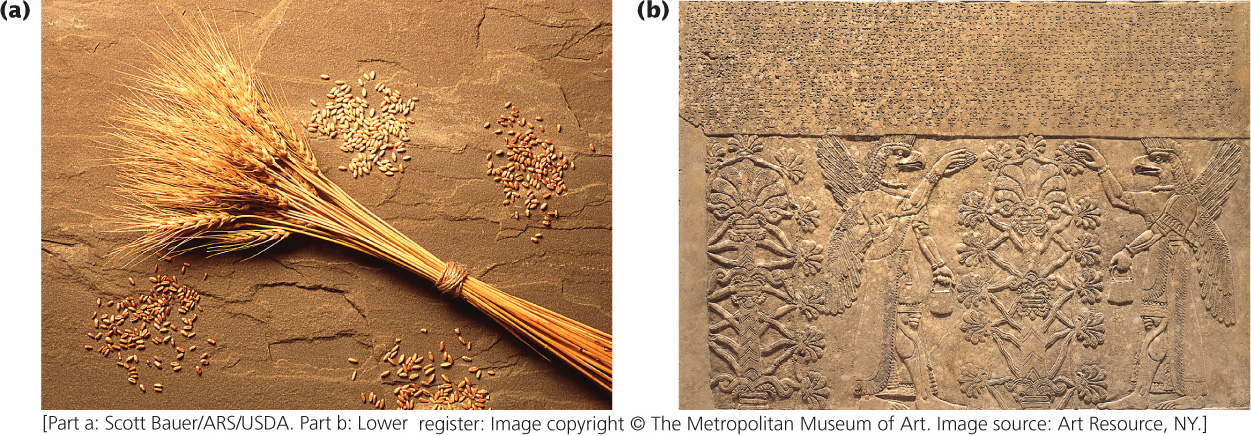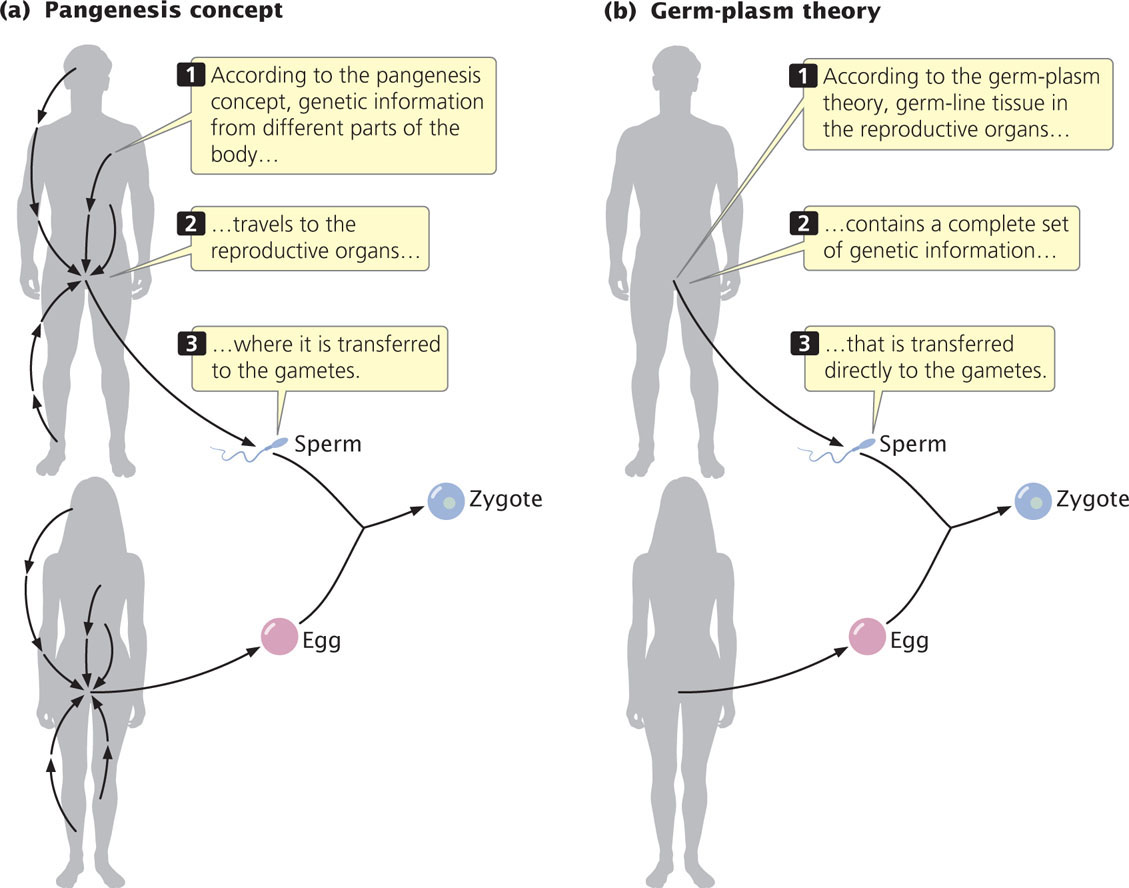1.2 Humans Have Been Using Genetics for Thousands of Years
Although the science of genetics is young—almost entirely a product of the past 100 years or so—people have been using genetic principles for thousands of years.
The Early Use and Understanding of Heredity
The first evidence that people understood and applied the principles of heredity in earlier times is found in the domestication of plants and animals, which began between approximately 10,000 and 12,000 years ago in the Middle East. The first domesticated organisms included wheat, peas, lentils, barley, dogs, goats, and sheep (Figure 1.9a). By 4000 years ago, sophisticated genetic techniques were already in use in the Middle East. The Assyrians and Babylonians developed several hundred varieties of date palms that differed in fruit size, color, taste, and time of ripening (Figure 1.9b). Other crops and domesticated animals were developed by cultures in Asia, Africa, and the Americas in the same period.

Ancient writings demonstrate that early humans were also aware of their own heredity. Hindu sacred writings dating to 2000 years ago attribute many traits to the father and suggest that differences between siblings are produced by the mother. The Talmud, the Jewish book of religious laws based on oral traditions dating back thousands of years, presents an uncannily accurate understanding of the inheritance of hemophilia. It directs that, if a woman bears two sons who die of bleeding after circumcision, any additional sons that she bears should not be circumcised; nor should the sons of her sisters be circumcised. This advice accurately corresponds to the X-linked pattern of inheritance of hemophilia (discussed further in Chapter 6).
8
The ancient Greeks gave careful consideration to human reproduction and heredity. Greek philosophers developed the concept of pangenesis, in which specific particles, later called gemmules, carry information from various parts of the body to the reproductive organs, from which they are passed to the embryo at the moment of conception (Figure 1.10). Although incorrect, the concept of pangenesis was highly influential and persisted until the late 1800s.

Pangenesis led the ancient Greeks to propose the notion of the inheritance of acquired characteristics, in which traits acquired in a person’s lifetime become incorporated into that person’s hereditary information and are passed on to offspring; for example, people who developed musical ability through diligent study would produce children who are innately endowed with musical ability. The notion of the inheritance of acquired characteristics is also no longer accepted, but it remained popular through the twentieth century.
Although the ancient Romans contributed little to an understanding of human heredity, they successfully developed a number of techniques for animal and plant breeding; the techniques were based on trial and error rather than any general concept of heredity. Little new information was added to the understanding of genetics in the next 1000 years.
Additional developments in our understanding of heredity occurred during the seventeenth century. Dutch eyeglass makers began to put together simple microscopes in the late 1500s, enabling Robert Hooke (1635–1703) to discover cells in 1665. Microscopes provided naturalists with new and exciting vistas on life, and perhaps excessive enthusiasm for this new world of the very small gave rise to the idea of preformationism. According to preformationism, inside the egg or sperm there exists a fully formed miniature adult, a homunculus, which simply enlarges in the course of development (Figure 1.11). Preformationism meant that all traits were inherited from only one parent—from the father if the homunculus was in the sperm or from the mother if it was in the egg. Although many observations suggested that offspring possess a mixture of traits from both parents, preformationism remained a popular concept throughout much of the seventeenth and eighteenth centuries.

9
Another early notion of heredity was blending inheritance, which proposed that offspring are a blend, or mixture, of parental traits. This idea suggested that the genetic material itself blends, much as blue and yellow pigments blend to make green paint. After having been blended, genetic differences could not be separated in future generations, just as green paint cannot be separated into blue and yellow pigments. Some traits do appear to exhibit blending inheritance; however, we realize today that individual genes do not blend.
The Rise of the Science of Genetics
In 1676, Nehemiah Grew (1641–1712) reported that plants reproduce sexually by using pollen from the male sex cells. With this information, a number of botanists began to experiment with crossing plants and creating hybrids, including Gregor Mendel (1822–1884; Figure 1.12), who went on to discover the basic principles of heredity. Mendel’s conclusions, which were not widely known in the scientific community for 35 years, laid the foundation for our modern understanding of heredity, and he is generally recognized today as the father of genetics.

Developments in cytology (the study of cells) in the 1800s had a strong influence on genetics. Robert Brown (1773–1858) described the cell nucleus in 1833. Building on the work of others, Matthias Jacob Schleiden (1804–1881) and Theodor Schwann (1810–1882) proposed the concept of the cell theory in 1839. According to this theory, all life is composed of cells, cells arise only from preexisting cells, and the cell is the fundamental unit of structure and function in living organisms. Biologists interested in heredity began to examine cells to see what took place in the course of cell reproduction. Walther Flemming (1843–1905) observed the division of chromosomes in 1879 and published a superb description of mitosis. By 1885, biologists generally recognized that the nucleus contained the hereditary information.
Charles Darwin (1809–1882), one of the most influential biologists of the nineteenth century, put forth the theory of evolution through natural selection and published his ideas in On the Origin of Species in 1859. Darwin recognized that heredity was fundamental to evolution, and he conducted extensive genetic crosses with pigeons and other organisms. However, he never understood the nature of inheritance, and this lack of understanding was a major omission in his theory of evolution.
In the last half of the nineteenth century, cytologists demonstrated that the nucleus had a role in fertilization. Near the close of the nineteenth century, August Weismann (1834–1914) finally laid to rest the notion of the inheritance of acquired characteristics. He cut off the tails of mice for 22 consecutive generations and showed that the tail length in descendants remained stubbornly long. Weismann proposed the germ-plasm theory, which holds that the cells in the reproductive organs carry a complete set of genetic information that is passed to the egg and sperm (see Figure 1.10b).
10
The year 1900 was a watershed in the history of genetics. Gregor Mendel’s pivotal 1866 publication on experiments with pea plants, which revealed the principles of heredity, was rediscovered, as considered in more detail in Chapter 3. The significance of his conclusions was recognized, and other biologists immediately began to conduct similar genetic studies on mice, chickens, and other organisms. The results of these investigations showed that many traits indeed follow Mendel’s rules. Some of the early concepts of heredity are summarized in Table 1.1.
| Concept | Proposed | Correct or Incorrect |
|---|---|---|
| Pangenesis | Genetic information travels from different parts of the body to reproductive organs. | Incorrect |
| Inheritance of acquired characteristics | Acquired traits become incorporated into hereditary information. | Incorrect |
| Preformationism | Miniature organism resides in sex cells, and all traits are inherited from one parent. | Incorrect |
| Blending inheritance | Genes blend and mix. | Incorrect |
| Germ-plasm theory | All cells contain a complete set of genetic information. | Correct |
| Cell theory | All life is composed of cells, and cells arise only from cells. | Correct |
| Mendelian inheritance | Traits are inherited in accord with defined principles. | Correct |
After the acceptance of Mendel’s theory of heredity, in 1902 Walter Sutton (1877–1916) proposed that genes, the units of inheritance, are located on chromosomes. Thomas Hunt Morgan (1866–1945) discovered the first genetic mutant of fruit flies in 1910 and used fruit flies to unravel many details of transmission genetics. Ronald A. Fisher (1890–1962), John B. S. Haldane (1892–1964), and Sewall Wright (1889–1988) laid the foundation for population genetics in the 1930s by integrating Mendelian genetics and evolutionary theory.
Geneticists began to use bacteria and viruses in the 1940s; the rapid reproduction and simple genetic systems of these organisms allowed detailed study of the organization and structure of genes. At about this same time, evidence accumulated that DNA was the repository of genetic information. James Watson (b. 1928) and Francis Crick (1916–2004), along with Maurice Wilkins (1916–2004) and Rosalind Franklin (1920–1958), described the three-dimensional structure of DNA in 1953, ushering in the era of molecular genetics.
By 1966, the chemical structure of DNA and the system by which it determines the amino acid sequence of proteins had been worked out. Advances in molecular genetics led to the first recombinant DNA experiments in 1973, which touched off another revolution in genetic research. Walter Gilbert (b. 1932) and Frederick Sanger (b. 1918) developed methods for sequencing DNA in 1977. The polymerase chain reaction, a technique for quickly amplifying tiny amounts of DNA, was developed by Kary Mullis (b. 1944) and others in 1983. In 1990, gene therapy was used for the first time to treat human genetic disease in the United States, and the Human Genome Project was launched. By 1995, the first complete DNA sequence of a free-living organism—the bacterium Haemophilus influenzae—was determined, and the first complete sequence of a eukaryotic organism (yeast) was reported a year later. A rough draft of the human genome sequence was reported in 2000 (see Chapter 20), with the sequence essentially completed in 2003, ushering in a new era in genetics (Figure 1.13). Today, the genomes of numerous organisms are being sequenced, analyzed, and compared.  TRY PROBLEMS 22 AND 23
TRY PROBLEMS 22 AND 23

The Future of Genetics
Numerous advances in genetics are being made today, and genetics remains at the forefront of biological research. New, rapid methods for sequencing DNA are being used to sequence the genomes of numerous species, from strawberries, to butterflies, to elephants. Recently, these methods were used to reconstruct the entire genome of an unborn fetus from fetal DNA circulating in the mother’s blood, providing the potential for noninvasive prenatal genetic testing. Analysis of DNA from ancient bones demonstrates that several different species of humans roamed the earth as recently as 30,000 years ago. Powerful modern genetic techniques are being used to identify genes that influence agriculturally important characteristics such as size in cattle, domestication in chickens, speed in racehorses, and leaf shape in corn. DNA analysis is now routinely used to identify and convict criminals, or prove the innocence of suspects.
11
The power of new methods to identify and analyze genes is illustrated by genetic studies of myocardial infarction (heart attack) in humans. Physicians have long recognized that heart attacks run in families, but finding specific genes that contribute to an increased risk of a heart attack has, until recently, been difficult. In 2009, an international team of geneticists examined the DNA of 26,000 people in 10 countries for single nucleotide differences in the DNA (called single-nucleotide polymorphisms, or SNPs) that might be associated with an increased risk of heart attack. This study and other similar studies identified several new genes that affect the risk of coronary artery disease and early heart attacks. These findings may make it possible to identify persons who are predisposed to heart attack, allowing early intervention that might prevent an attack. Analyses of SNPs are helping to locate genes that affect all types of traits, from eye color and height to glaucoma and cancer.
Information about sequence differences among organisms is also a source of new insights about evolution. For example, scientists recently analyzed DNA sequences at 26 genes to construct a comprehensive evolutionary tree of mammals. The tree uncovers many interesting features of mammalian evolution. One such revelation is that marine mammals (whales, dolphins, and porpoises) are most closely related to hippos.
In recent years, scientists have discovered that alterations to DNA and chromosome structure that do not involve the base sequence of the DNA play an important role in gene expression. These alterations, called epigenetic changes, affect our appearance, behavior, and health and are currently the focus of intense research. Other studies demonstrate that RNA is a key player in many aspects of gene function. The discovery in the late 1990s of tiny RNA molecules called small interfering RNAs and micro RNAs led to the recognition that these molecules play central roles in gene expression and development. New genetic microchips that simultaneously analyze thousands of RNA molecules are providing information about the activities of thousands of genes in a given cell, allowing a detailed picture of how cells respond to external signals, environmental stresses, and diseases such as cancer. In the field of proteomics, powerful computer programs are being used to model the structure and function of proteins from DNA-sequence information. All of this information provides us with a better understanding of numerous biological processes and evolutionary relationships. The flood of new genetic information requires the continuous development of sophisticated computer programs to store, retrieve, compare, and analyze genetic data and has given rise to the field of bioinformatics, a merging of molecular biology and computer science.
As the cost of sequencing becomes more affordable, the focus of DNA-sequencing efforts will shift from the genomes of different species to individual differences within species. In the not-too-distant future, each person will likely possess a copy of his or her entire genome sequence, which can be used to help assess the risk of acquiring various diseases and to tailor their treatment should they arise. The use of genetics in agriculture will continue to improve the productivity of domestic crops and animals, helping to feed the future world population. This ever-widening scope of genetics raises significant ethical, social, and economic issues.
This brief overview of the history of genetics is not intended to be comprehensive; rather it is designed to provide a sense of the accelerating pace of advances in genetics. In the chapters to come, we will learn more about the experiments and the scientists who helped shape the discipline of genetics.
CONCEPTS
Humans first applied genetics to the domestication of plants and animals between 10,000 and 12,000 years ago. Developments in plant hybridization and cytology in the eighteenth and nineteenth centuries laid the foundation for the field of genetics today. After Mendel’s work was rediscovered in 1900, the science of genetics developed rapidly and today is one of the most active areas of science.
 CONCEPT CHECK 3
CONCEPT CHECK 3
How did developments in cytology in the nineteenth century contribute to our modern understanding of genetics?